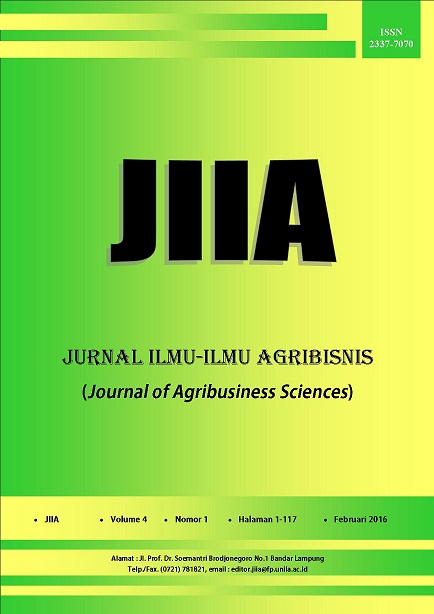ANALISIS USAHATANI DAN PEMASARAN BAWANG MERAH DI KABUPATEN TANGGAMUS
DOI:
https://doi.org/10.23960/jiia.v4i1.1208 Abstract View: 1845
Abstract View: 1845
Abstract
This study aims to analyze (1) onion farm income and (2) efficiency of onion marketing system. Research was conducted in Tanggamus Regency which chosen purposely and total of samples was 35 farmers and 16 traders in marketing system. Sampling methods of farmers was used by census method, whereas the sampling method of marketing system was used by snowball method. Data collection was conducted in October 2014 until February 2015. Analysis methods used in this research are the analysis of quantitative (statistical) and qualitative (descriptive). The research result showed that (1) onion farm in Tanggamus Regency economically advantageous, base on the value of total cost R/C ratio > 1, on the first crop season of 1,73. (2) The marketing system of the onion in Tanggamus was not efficient due to the margin profit ratio in each marketing organization have not spread evenly, and the price difference (margin) in each marketing organization was too large, although the value of the producer share was quite large, with appromiximately 61,5%-76,9%.
Key words: income, marketing, onion farm
Downloads
Downloads
Published
How to Cite
Issue
Section
License
Authors who publish with this journal agree to the following terms:
Authors retain copyright and grant the journal right of first publication with the work simultaneously licensed under a Creative Commons Attribution License that allows others to share the work with an acknowledgement of the work's authorship and initial publication in this journal.
Authors are able to enter into separate, additional contractual arrangements for the non-exclusive distribution of the journal's published version of the work (e.g., post it to an institutional repository or publish it in a book), with an acknowledgement of its initial publication in this journal.
Authors are permitted and encouraged to post their work online (e.g., in institutional repositories or on their website) prior to and during the submission process, as it can lead to productive exchanges, as well as earlier and greater citation of published work (See The Effect of Open Access).














